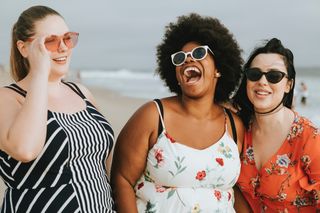Friends
The Secret to Making Friends as an Adult
Research informs how you can make more friends.
Posted August 20, 2019 Reviewed by Devon Frye

I've lived my 20s as a part-time nomad, flip-flopping between New York City and Washington, D.C., wandering around Haiti for two summers, and spending six months in Trinidad and Tobago. I settled in Atlanta for my first job as a college professor. What I was most anxious about during all of these trips was never culture shock or homesickness. It was making friends. I would be haunted by visions of myself, isolated, in a new city or country.
When I think back as to where some of these fears came from, I realize that they sprouted up during college. As a new student at New York University, I had no idea how to form connections. I figured it would happen "naturally," but it didn't. I stuck around some friends who had gone to my high school and we navigated NYU together. But I also remember being lonely much of the time. I tried to join a group for board game lovers, but when no one engaged with me, I gave up. Eventually, I started to make some new connections. I joined the Applied Psychology club and that started to feel like a home, where I made many of my closest friends from college.
There are a few things I wish I would have known that would have helped my college-aged self, hungry for connections but clueless as to how to make them. I've been writing a book about the psychology of friendship, and reviewing the research has given me a series of revelations.
First, friendships don't just happen. In fact, the belief that they happen organically can hinder our chances of making friends.
One study found that believing that friendship happens based on luck was related to more loneliness five years later, whereas believing that friendship takes effort was related to less loneliness. Why? The people who believed making friends took effort put the effort in. They showed up at events and were intentional about making connections. Many of us may rely on the belief that no-matter-what-I-do-I-won't-make-friends. That sort of thinking becomes a self-fulfilling prophecy. The evidence shows that if you put yourself out there, you are much more likely to make friends.
But what does it mean to put yourself out there? I thought that showing up at the board game club was enough, but it wasn't. Ellen Hendriksen, author of How to Be Yourself: Quiet Your Inner Critic and Rise Above Social Anxiety, differentiates between overt and covert avoidance. Overt avoidance means failing to show up at events and clubs, and covert avoidance means failing to engage with people when you get there. We have to overcome both overt and covert avoidance to make friends. It's not enough just to place yourself in the vicinity of others if you're not willing to introduce yourself.
Many of us see ourselves as passive agents of our social worlds, waiting for someone else to reach out to us and introduce themselves, but we must embrace the idea that we are in more control of our social worlds than we think. The more intentional we are about connecting with others, the more we benefit.
One study examined classmates’ perceptions of the social environment of their classroom. Was it chilly or welcoming? People in the same class perceived it differently. Mostly, people's perception of the social environment depended on their behaviors within it. Those who engaged with others regarded it as friendly, whereas those who kept to themselves saw it as unwelcoming. And the people who do engage with others tend to believe that others like them and are open to meeting them, a useful mantra to repeat to yourself if you are hoping to initiate with others. It's also backed by science; in my other post, I describe research that finds that we systematically underestimate how much people like us.
Our perception of the world around us depends on the actions we take to carve out space for ourselves to connect. If you think a group is cliquey or unfriendly, ask yourself what you’ve done to engage with them. If you've tried and they've turned you down, then that conclusion may be warranted. But if you've kept to yourself and are resentful because no one has approached you, then it's time to take ownership for forming the connection.
I have one last message for younger-me—because she did something right. A famous tenet of psychology is called the "mere exposure effect." People like us more if they are merely exposed to our face. One study involved planting strangers in a college class, for a varying number of classes. The strangers didn’t interact with the students, and yet the students reported liking the stranger who showed up for many classes more than the one who showed up for fewer. Students' likeability ratings were 20 percent higher for the stranger who showed up to the class the most, compared to the one who showed up the least.
This means that if we show up, regularly, people will come to like us more and more over time. So, we should never judge a new club or class based on our impressions during the first meeting, when everyone is stilted and threatened by unfamiliar characters. For me, being able to stick out the Applied Psychology club was a game-changer. Knowing about mere exposure means that we all need to not just show up and engage but show up continuously.
This might sound like a lot of work. Shouldn't friendships just happen like they did when we were younger? The sooner we rid ourselves of the belief that they do, the sooner we will make friends. In being intentional about our relationships now, we are curating our future lives. If we envision a world for ourselves where we are thriving with connection, surrounded by people we love and who love us, then we have to start building that world now.
Note: This article is reposted on my website where you can take a quiz to assess your friendship skills.
References
Newall, N. E., Chipperfield, J. G., Clifton, R. A., Perry, R. P., Swift, A. U., & Ruthig, J. C. (2009). Causal beliefs, social participation, and loneliness among older adults: A longitudinal study. Journal of Personal and Social Relationships, 26, 273-290
Eronen, S., & Nurmi, J. (1999). Social reaction styles, interpersonal behaviors and person perception: A multi-informant approach. Journal of Personal and Social Relationships, 16, 315-333.
Moreland, R. L., & Beach, S. R. (1992). Exposure effects in the classroom: The development of affinity among students. Journal of Experimental Social Psychology, 28, 255-276.




